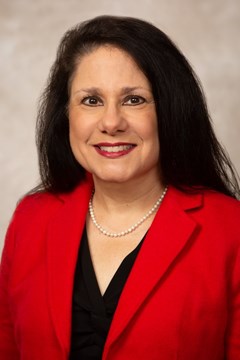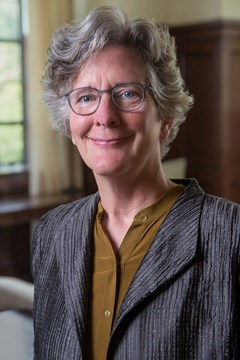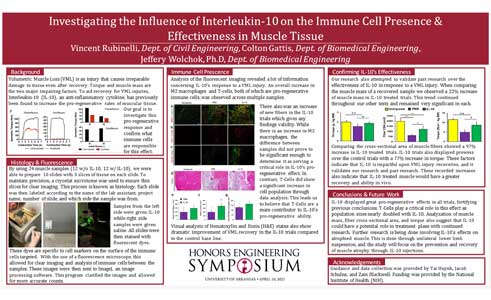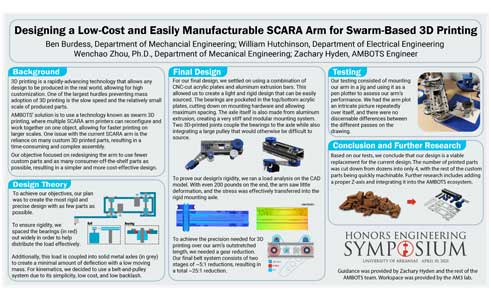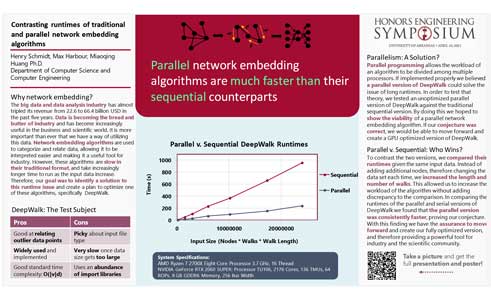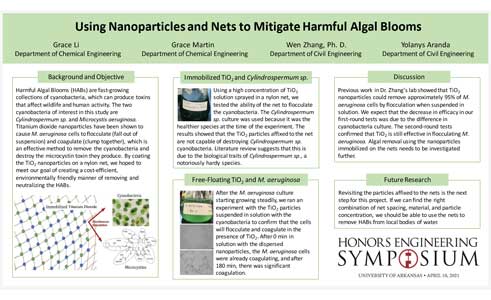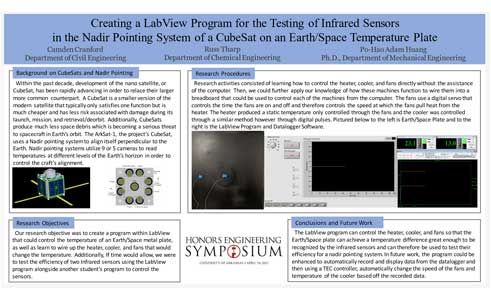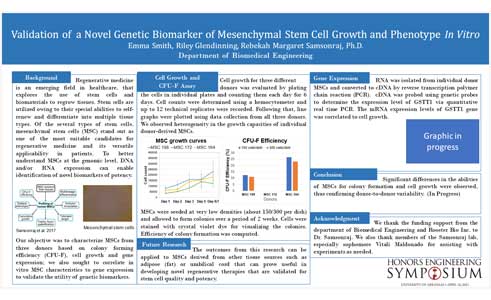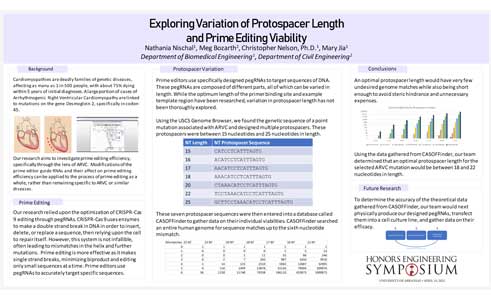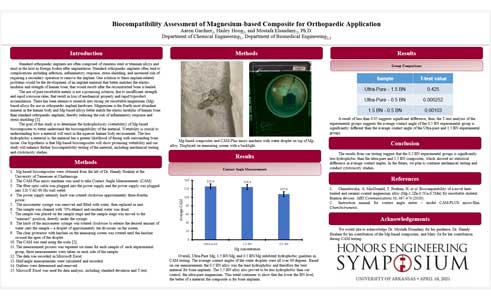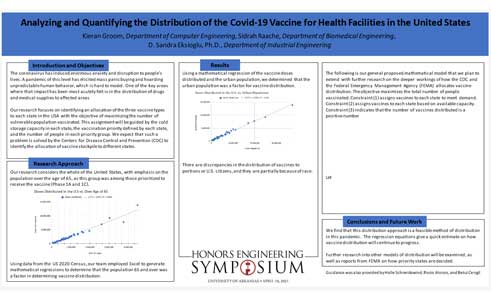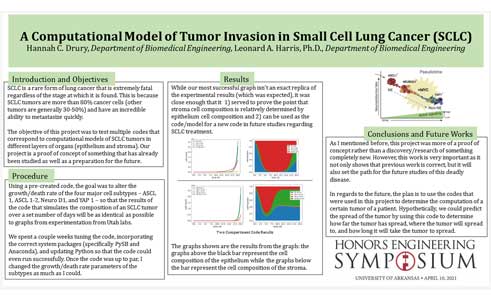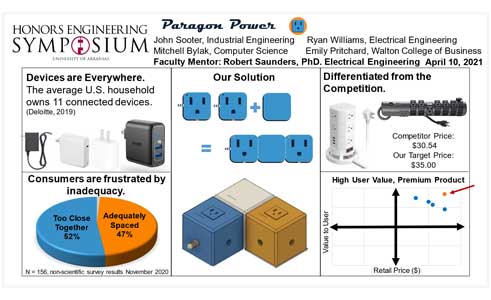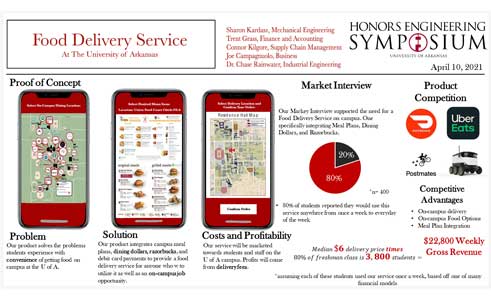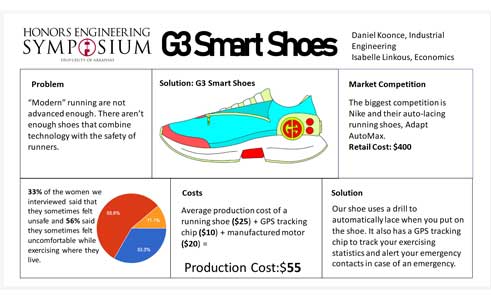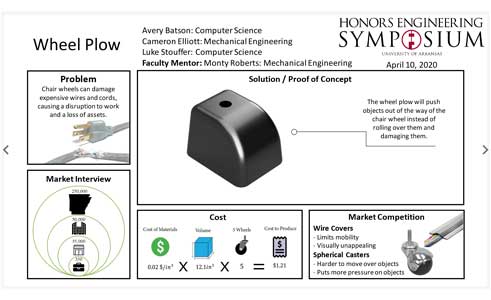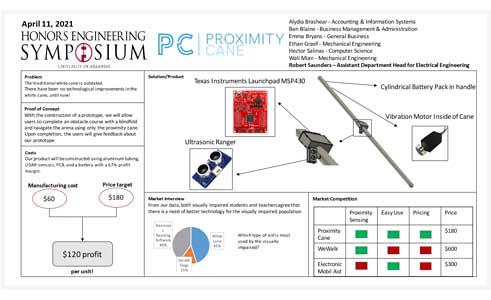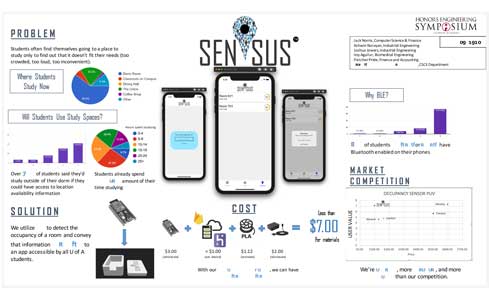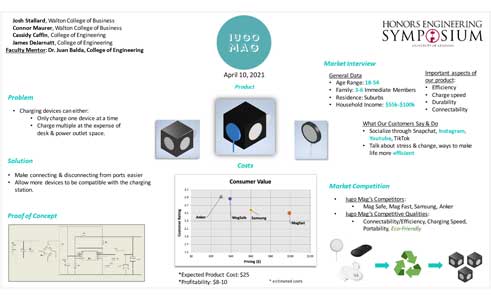
Due to COVID-19 only verified participants, judges and support staff may attend this in-person event. Remote attendees are welcome to join the presentations through the Zoom links provided in the Symposium Schedule by clikcing the 'Schedule of Events' button.
A MESSAGE FROM THE DIRECTOR
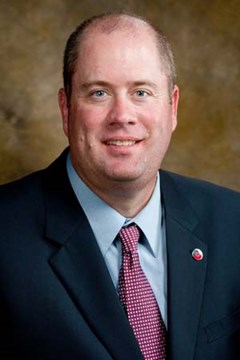
On behalf of the faculty and staff of the College of Engineering at the University of Arkansas, it is my pleasure to welcome you to the 13th Annual Honors Engineering Symposium. The purpose of the symposium is to showcase the research and innovation efforts of 38 first-year engineering students and 10 first-year business students who are enrolled in the Honors College.
Nineteen students participated in a research colloquium during the fall semester in which they learned about various aspects of academic research in an engineering program. Throughout the year, the students have worked individually or in teams on projects mentored by College of Engineering faculty. The 10 research projects cover several areas of tremendous recent attention in the engineering professions.
Twenty-nine students participated in an innovation colloquium during the fall semester in which they learned about various aspects of innovation and entrepreneurship. Throughout the year, the students have worked in teams on projects mentored by College of Engineering faculty to help them with innovative design projects. The student teams also had to consider product market and business development plans.
We invite remote attendees to view the student posters, to watch the presentations sessions, and to view the awards ceremonies.
I appreciate your support and again welcome you to our 13th Annual Honors Engineering Symposium.
Sincerely,
C. Richard Cassady, Ph.D.
College of Engineering Honors Program Director
Dean Kim Needy, College of Engineering
Dean Lynda Coon, Honors College
RESEARCH TEAMS
Investigating the Influence
of IL-10 on Immune Cell
Presence & Effectiveness
in Muscular Tissue
Students
Colton Gattis | Biomedical Engineering
Vincent Rubinelli | Civil Engineering
Faculty Mentor
Dr. Jeff Wolchok | Biomedical Engineering
Project Description
Volumetric Muscle Injury (VML) is a muscle injury characterized by the traumatic loss of a significant portion of muscle tissue resulting in a loss in ability. Previous studies indicate that the introduction of a signaling molecule, known as Interleukin-10, promotes VML recovery. We seek to better understand which immune cell populations Interleukin-10 influences to achieve this pro-regenerative effect. Utilizing histology and fluorescent staining, we will properly analyze IL-10's effects on common immune cells.
Designing a Low-Cost
and Easily Manufacturable
SCARA Arm for Swarm-Based
3D Printing
Student Researchers
Ben Burdess | Mechanical Engineering
William Hutchinson | Electrical Engineering
Faculty Mentor
Wenchao Zhou, Ph.D. | Mechanical Engineering
Project Description
Swarm 3D printing is a technology where multiple printers work together on one object allowing for scalability and flexibility in manufacturing. AMBOTS currently uses a SCARA arm that reaches out to print, but this design is highly custom and time-consuming to manufacture. Our task was to redesign the arm to be lower cost and more easily manufacturable. We used aluminum extrusion and CNC milled plates to create a rigid and modular arm for 3D printing.
Contrasting runtimes
of traditional
and parallelized network
embedding algorithms
Student Researchers
Henry Schmidt | Computer Science & Computer Engineering
Maxwell Harbour | Computer Science & Computer Engineering
Faculty Mentor
Miaoqing Huang, Ph.D. | Computer Science & Computer Engineering
Project Description
Data in the modern world is constantly flowing but without a way to relate it, it has no use. Network embedding algorithms such as DeepWalk and node2vec allow us to create connections between seemingly unlike data points. However, the speed at which these algorithms work increases greatly with the size of the input data set. In our presentation we will showcase the possible advantages of utilizing GPU clusters to reduce the runtimes of these algorithms.
Using Nets and
Nanoparticles
to Mitigate
Harmful Algal Blooms
Students
Grace Li | Chemical Engineering
Grace Martin | Chemical Engineering
Faculty Mentor
Wen Zhang, Ph.D. | Civil Engineering
Yolanys Aranda, Senior Honors Student | Civil Engineering
Project Description
Harmful algae blooms (HABs) produce cyanotoxins, which negatively impact the environment and human health. Both marine and freshwater bodies, including our local Lake Fayetteville, are affected by HABs. Current practices for treatment include pumping water into treatment facilities to remove toxins, which is costly and changes the landscape near the affected body of water. Our research explores the efficacy of titanium dioxide nanoparticles as a possible alternative for in situ treatment.
Testing of an Infrared
Nadir-Pointing System
for a CubeSat
Students
Camden Cranford | Civil Engineering
Russ Tharp | Civil Engineering
Faculty Mentor
Po-Hao Adam Huang, Ph.D. | Mechanical Engineering
Project Description
This project provides an overview of the testing of several infrared sensors for use in a nadir-pointing system on the university’s first CubeSat, the ArkSat-1. Our team created programs in LabView to control and monitor the temperatures of a custom Earth and Space plate, to simulate realistic atmospheric and space temperatures, as well as test the viability of several infrared sensors based on their ability to distinguish between the two different temperatures.
Validation of a Novel Genetic Biomarker of Mesenchymal Stem Cell Growth and Phenotype In Vitro
Students
Emma Smith | Biomedical Engineering
Riley Glendinning | Biomedical Engineering
Faculty Mentor
Rebekah Margaret Samsonraj, Ph.D. | Biomedical Engineering
Project Description
Our project is a validation experiment of Dr. Rebekah Samsonraj’s research on genomic biomarker discovery that correlates with growth capacity of mesenchymal stem cells (MSCs). We are performing a double-blinded experiment on MSCs from three donors in assessing parameters such as cell growth, colony-forming efficiency, and gene expression followed by comparing phenotype results with gene expression to verify if the absence of the identified biomarker gene results in increased cell growth.
Exploring Variation
of Protospacer
Length and Prime
Editing Viability
Students
Meg Bozarth | Civil Engineering
Nathania Nischal | Biomedical Engineering
Faculty Mentor
Christopher Nelson, Ph.D. | Biomedical Engineering
Mary Jia, Student Mentor | Biomedical Engineering
Project Description
Arrhythmogenic Right Ventricular Cardiomyopathy is a deadly disease that prevents regular beating of the heart. Many cases are caused by a point mutation on Desmoglein2 which alters the amino acid produced. To remedy this, pegRNA complexes needed to be designed for use in gene therapy: the first for mutation insertion and the other for removal. These pegRNA complexes were then run through CASOFFinder to determine their theoretical viability as prime editors for the desired site.
Biocompatibility Assessment
of Magnesium-based
Biocomposites for Bone
Implant Applications
Students
Hailey Hoog | Biomedical Engineering
Aaron Gardner | Chemical Engineering
Faculty Mentor
Mostafa Elsaadany, Ph.D. | Biomedical Engineering
Project Description
Magnesium-based biocomposites offer an alternative to standard orthopaedic implants due to their biodegradability and elastic modulus similar to that of human bone. These composites have potential to lower the risk of stress shielding and reduce inflammation, but require further cytotoxicity testing. The biocompatibility of three Magnesium-based alloys (0.5 BN, 1.5 BN, and ultra-pure Magnesium) was assessed through Contact Angle Measurement (CAM) to determine the hydrophilicity of the samples.
Optimizing Supply Chain
Models to the Distribution
of COVID-19 Vaccines
in the United States
Students
Sidrah Raache | Biomedical Engineering
Kieran Groom | Computer Science & Computer Engineering
Faculty Mentor
D. Sandra Eksioglu, Ph.D. | Industrial Engineering
Project Description
Our objective was to develop a supply chain system model specified for states in the US depending on density and age of the population, and the cold storage capacity to maximize coverage. We have come up with a model based on how the US is conducting the current vaccine distribution and our stated parameters to see how it could be improved.
A computational model of tumor invasion in small cell lung cancer
Students
Hannah C. Drury | Biomedical Engineering
Faculty Mentor
Leonard A. Harris | Biomedical Engineering
Project Description
Small cell lung cancer (SCLC) is an aggressive disease known for quickly developing resistance to chemotherapy and metastasizing. Recent research has identified multiple cell subtypes of SCLC that are hypothesized to form a microecosystem that supports tumor growth. In this project, we extend a computational model of the SCLC tumor in order to reproduce experimental results. The long-term goal is to use the model to develop treatments for SCLC by slowing, or preventing, metastasis.
INNOVATION TEAMS
Paragon
Powerstrip
Students
John Blake Sooter | Industrial Engineering
Ryan Williams | Electrical Engineering
Mitchell Bylak | Computer Science & Computer Engineering
Emily Pritchard | Walton College of Business
Faculty Mentor
Robert Saunders, P.E. | Electrical Engineering
Project Description
Our project provides a streamlined solution to the growing problem of power delivery for consumer electronic devices. Most consumer devices come with various sized, device-specific power adapters that block up to half of the AC outlets on a basic power strip. We propose a modular solution that enables the end user to arrange each outlet to their needs. This maximizes the usefulness of each outlet, improves aesthetic, and provides a superior user experience.
Food Delivery Service at the University of Arkansas
Students
Trent Grass | of Student Finance and Accounting, Walton College of Business
Joe Campagnuolo | Walton College of Business
Connor Kilgore | Student Chain Management, Walton College of Business
Sharon Kardasz | Mechanical Engineering
Faculty Mentor
Chase Rainwater, Ph.D. | Industrial Engineering
Project Description
Do you struggle to find time to eat meals during busy days on campus? Are you looking for an on-campus job with flexible hours? This pitch deck outlines the development of a food delivery service at The University of Arkansas. This service includes the integration of meal swipes and dining dollars as payment for delivery of any food item from any location on campus to your straight to your dorm.
G3 Smart
Shoes
Students
Daniel Koonce | Industrial Engineering
Isabelle Linkous | Walton College of Business
Faculty Mentor
Alexander Nelson,Ph.D. | Computer Science & Computer Engineering
Project Description
What if there was a smarter way to run that also kept you safe? Our product combines technology with traditional running shoes to maximize your running experience while keeping you safe. Our shoes are automatic-lacing and have a tracking device to keep your running statistics while also having an emergency button that contacts local authorities in case of an emergency.
Wheel Plow
Students
Avery Batson | Computer Science & Computer Engineering
Cameron Elliott | Mechanical Engineering
Luke Stouffer | Computer Science & Computer Engineering
Faculty Mentor
Monty Roberts | Mechanical Engineering
Project Description
With more people working from home than ever before, protection of office equipment is at a premium. This presentation introduces an efficient device which will protect valuable objects such as cords and clothing from chair wheels by pushing them out of the way rather than rolling over them.
Proximity Cane
Students
Ethan Graef | Mechanical Engineering
Hector Salinas | Computer Science & Computer Engineering
Wali Mian | Mechanical Engineering
Alydia Brashear | Accounting & Information Systems, Walton College of Business
Ben Blaine | Business Management & Administration, Walton College of Business
Emma Grace Bryans | Business, Walton College of Business
Faculty Mentor
Robert Saunders, P.E. | Electrical Engineering
Project Description
Technology has improved the lives of so many people in the world, yet there is a lack of innovative, affordable technology for the blind and visually impaired. Our product takes a look at how we can improve the standard White Cane by using motion sensing technology to better the everyday mobility of the visually impaired.
Sensus
Students
Jack Norris | Computer Science & Computer Engineering, College of Engineering & Finance, Walton College of Business
Ashwin Narayan | Industrial Engineering
Joshua Jowers | Industrial Engineering
Izzy Aguilar | Biomedical Engineering
Fletcher Pride | Finance and Accounting, Walton College of Business
Samson Parker | Mechanical Engineering & Music, Fulbright College of Arts and Sciences
Faculty Mentor
Alexander Nelson, Ph.D. | Computer Science & Computer Engineering
Project Description
What if you could see how crowded a location was before going there? This pitch deck examines user-friendly technology that enables students to conveniently find open study spaces across campus. By utilizing Bluetooth technology and simple hardware, we give students the ability to view the occupancy levels of various study spaces, all through the convenience of a mobile app.
Iugo Mag
Students
Cassidy Caffin | Biomedical Engineering
Caleb DeJarnatt | Electrical Engineering
Connor Maurer | Accounting, Walton College of Business
Josh Stallard | Business Management, Walton College of Business
Faculty Mentor
Juan Balda,Ph.D. | Electrical Engineering
Project Description
The next step in wireless charging is not just fast approaching: it’s here! This pitch deck investigates the expanding opportunities of wireless power transfer for portable electronic devices. This new wireless power transfer goes beyond the traditional cord-to-outlet charging by taking advantage of the benefits of magnets. Success of the product has implications for the convenience of day-to-day life in a technological era.
